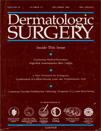Skin Resurfacing of Facial Rhytides and Scars with the 90-μs Short Pulse CO2 Laser
Comparison to the 900-μs Dwell Time CO2 Lasers and Clinical Experience
Abstract
background
Carbon dioxide lasers that produce either short pulses or scanned continuous beams have been used for skin resurfacing to improve wrinkles or scars. Using a high peak power, short pulse CO2 laser can produce clinically effective results with minimal thermal damage.
objective
To evaluate the effectiveness of skin resurfacing using the 90-μs pulse duration CO2 laser compared to other laser systems. Erythema, healing time, complications, and histological measurement of the depth of ablation and thermal damage per pass with this system were also assessed.
methods
Forty-one patients with facial rhytides and scars underwent resurfacing with a 90 μsec pulse duration CO2 laser. Using patient survey, patients were evaluated for effectiveness of therapy, healing time, and complication rates. Comparisons of histologic and clinical findings were made with different short pulse CO2 lasers. results. Healing time, duration of erythema, and post-operative pain were less with the 90 μs pulse CO2 laser than with the 900-μs dwell time and 950-μs pulse duration lasers, while effectiveness was comparable. Complications were few with the 90-μs pulse laser, including three patients (9.1%) developing hyperpigmentation. One pass with the 90-μs pulse duration CO2 laser produced 100 μm of ablation with 17 μm of thermal damage. Ablation and damage were additive so that, by six passes, ablation depth was 350 μm and depth of thermal damage was 63 μm. This thermal damage is less than that reported with lasers having a longer pulse duration or dwell time with comparable depths of vaporization.
conclusion
Treatment with the 90-μs pulse duration laser results in a more rapid healing time and shorter duration erythema. The clinical improvements in wrinkles and sun damage were comparable. The 90-μs pulse duration laser provides an effective, predictable, and safe means of improving facial rhytides and scars.




